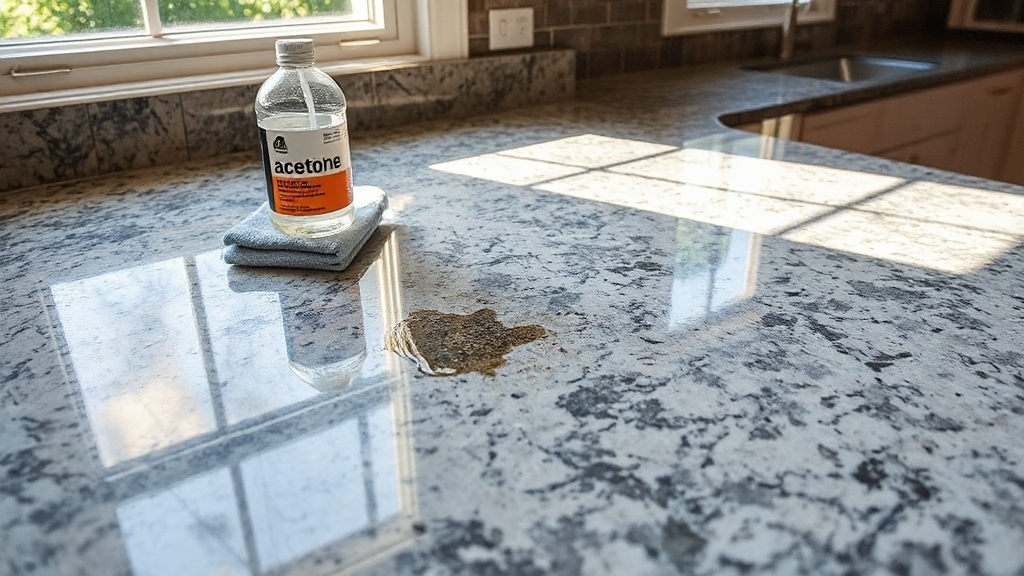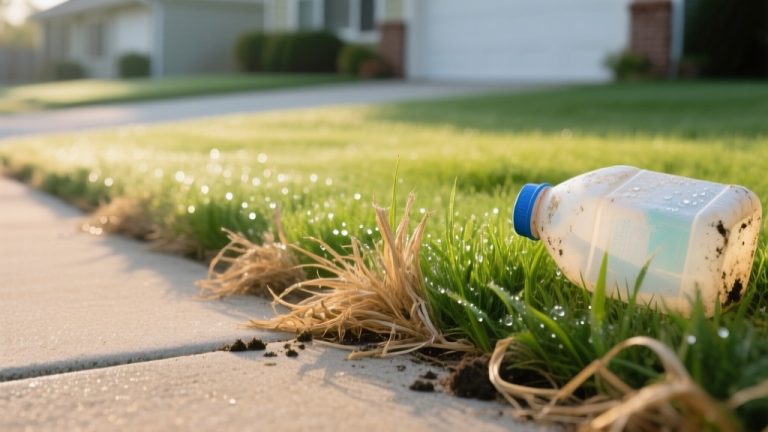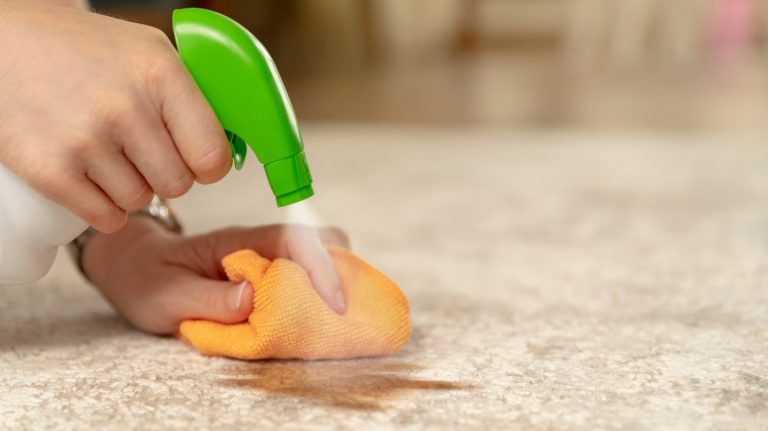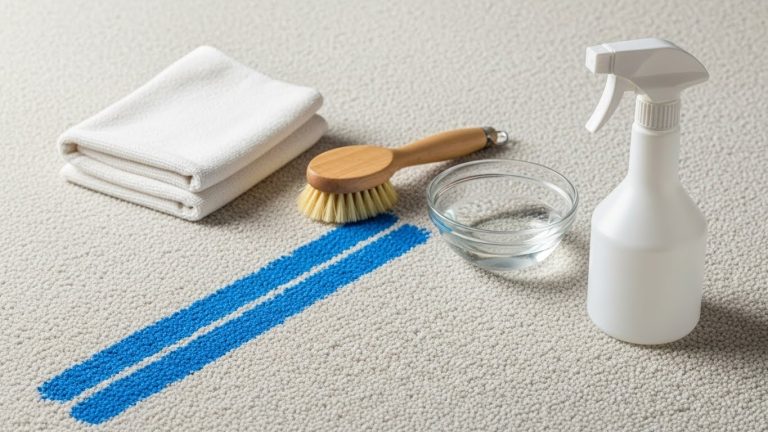Does Acetone Remove Oil Stains From Granite? Key Facts
Yes, acetone can remove oil stains from granite effectively because it dissolves oils better than many household cleaners.
You should apply it carefully with a soft cloth, test a small area first, and avoid overuse since it may strip the sealant. Always protect your skin and ventilate the space.
After cleaning, resealing the granite is essential to maintain its finish. If you want to tackle tougher stains or explore safer alternatives, there’s more to reflect on.
Key Takeaways
- Acetone effectively dissolves and removes oil stains from granite by breaking down oil-based substances.
- It is safe for dark granite if applied carefully and not overused to avoid stripping sealants.
- Apply acetone with a soft rag, blot gently, and always test on a small area first.
- Combining acetone with baking soda or talc creates powerful pastes or poultices for tough oil stains.
- After cleaning, thoroughly rinse, dry, and reseal granite to restore protection and prevent future stains.
How Acetone Works on Oil Stains in Granite?
Although granite is a durable surface, oil stains can still penetrate and cause damage, so using acetone can be an effective way to tackle these stains.
Acetone works by dissolving oils and fats through its strong chemical solvency, breaking down oil-based substances to penetrate and lift the stain. It acts rapidly, often outperforming household detergents in removing cooking oil, grease, and cosmetic stains.
Acetone rapidly dissolves oils and fats, effectively lifting tough stains like cooking oil and grease.
Generally, acetone is safe for granite when applied correctly, especially on dark granite where bleaching risks are lower. It’s often preferred over slower solvents like mineral spirits due to its speed and efficiency.
Since each granite piece is unique based on color, hardness, and pattern, testing acetone on a small area is recommended before full application.
Safe Application Practices for Using Acetone on Granite
Below are safe application practices to follow when using acetone on granite to remove oil stains effectively without causing damage:
Proper Acetone Usage
Since acetone is a potent solvent, you should handle it with care to protect both yourself and your granite surface. Always wear gloves and guarantee good ventilation to avoid harmful vapors.
Use pure acetone, not nail polish remover, to prevent unwanted chemicals. Apply acetone with a clean white cloth, blotting gently rather than rubbing to avoid damaging the granite’s polish. Acetone may remove polish unevenly, so caution is needed to maintain the granite’s finish (uneven polish removal).
For tougher oil stains, you might mix acetone with baking soda or gently use 0000-grade steel wool, but avoid abrasive tools that risk scratching. Test a small area first to confirm it won’t harm your granite.
After treatment, clean the area thoroughly and consider resealing the surface to restore protection. Handle acetone cautiously and dispose of materials according to safety guidelines.
Granite Surface Protection
Handling acetone carefully protects both you and your granite, but you also need to safeguard the stone itself during and after cleaning.
Acetone removes stubborn stains but strips away sealants, so always test on a small area first and reseal promptly after use. Avoid acidic cleaners and heat exposure to prevent etching or damage.
Regular maintenance with stone-safe cleaners preserves your granite’s finish. It is also important to clean up any spills immediately to prevent dark spots from moisture absorption, which can cause permanent stains.
| Practice | Action | Reason |
|---|---|---|
| Test First | Apply acetone on a small spot | Prevent unexpected damage |
| Use Sparingly | Limit acetone application | Avoid sealant stripping |
| Immediate Reseal | Seal granite after cleaning | Restore protection |
| Avoid Heat | Don’t place hot items on stone | Protect sealant and finish |
| Professional Help | Call experts for deep stains | Guarantee safe and effective cleaning |
Combining Acetone With Other Cleaning Agents for Tough Stains
You can boost acetone’s effectiveness on tough oil stains by mixing it with baking soda to form a gentle abrasive paste. This method helps to draw out oil from the tiny holes called pores in the granite.
While talc may also help absorb oils, avoid scrubbing with steel wool, as it can scratch your granite’s surface. Always test any combination on a small area first to prevent damage.
Baking Soda Paste
When tackling tough oil stains on granite, combining baking soda with acetone creates a powerful paste that leverages both cleaning agents’ strengths.
Mix equal parts baking soda and acetone to form a paste like pancake batter. This paste dissolves and absorbs oil effectively but requires careful use to safeguard your granite’s sealant.
It is important to note that stains require complete removal of the contaminant to disappear, as they persist and do not leave on their own persistent stains.
To apply the baking soda-acetone paste:
- Spread a thick layer over the stain and cover it with plastic wrap to keep it moist.
- Leave it for several hours or overnight, reapplying if needed for stubborn stains.
- Gently remove residue and clean with a granite-safe cleaner, avoiding prolonged acetone exposure.
Talc and Acetone
Combining talc with acetone creates a potent poultice that tackles tough oil stains on granite more effectively than acetone alone.
You mix talc powder with acetone to form a thick paste, which allows acetone to dissolve the oil while talc absorbs the loosened particles.
Apply this poultice generously over the stain, cover it with plastic wrap, and seal the edges with tape to retain moisture and maximize stain removal.
Leave it for one hour to overnight, depending on the stain’s severity, then carefully remove and clean the area.
Use acetone sparingly and always test a small area first, since acetone can damage granite sealants. After treatment, reseal your granite promptly to protect it from future damage.
Steel Wool Scrubbing
Tackle tough granite stains by carefully incorporating steel wool scrubbing alongside appropriate cleaning agents, but avoid pairing steel wool directly with acetone.
Steel wool is best reserved for gentle scrubbing of water spots or polishing, not for oil-based stains where acetone excels. Combining acetone with soft, stone-safe rags guarantees stain removal without scratching.
When dealing with persistent stains, consider these points:
- Use fine steel wool (0000 grit) with mild soap or cleaners—never with acetone—to avoid surface damage. It is important to blot spills immediately rather than wiping to prevent stains from spreading.
- Apply acetone with a soft rag for oil stains, then reseal your granite to protect it.
- For complex stains, try poultices or multi-agent approaches rather than abrasive scrubbing.
Precautions to Take When Using Acetone on Granite Surfaces
Although acetone can effectively tackle certain stains on granite, you must take specific precautions to protect both yourself and the surface.
First, make certain you work in a well-ventilated area to avoid inhaling harmful fumes. Always wear gloves and safety goggles to prevent skin and eye irritation.
Ensure proper ventilation and wear gloves and goggles to protect against fumes and irritation.
Keep acetone away from open flames and sparks due to its high flammability, and have a fire extinguisher nearby.
Test acetone on a small, hidden granite spot before full application to check for any adverse reactions. It is also important to consult a professional for difficult stains, such as rust, on granite.
Avoid mixing acetone with other chemicals and never use it on wet granite, as moisture can reduce its effectiveness. Store acetone away from heat and sunlight to maintain safety and product integrity.
Post-Cleaning Steps to Protect Granite After Acetone Use
Once you finish using acetone on your granite, you should immediately rinse the surface thoroughly with clean water to remove any remaining residue. This step helps prevent water absorption that can lead to stains and damage.
Next, dry the granite completely to prevent water spots and potential damage. Finally, apply a stone-safe sealer to restore protection and prevent future stains.
Follow these essential post-cleaning steps:
- Dry Completely: Use a soft cloth to guarantee no moisture remains, avoiding water spots or streaks.
- Test the Sealer: Apply the sealer to a discreet area first to confirm it doesn’t alter the granite’s color or finish.
- Seal Properly: Use a water-based, fluorochemical sealer suitable for your granite type, and reapply every six months for ongoing protection. Regular resealing enhances the appearance and cleanliness of your countertops.
Alternatives to Acetone for Different Types of Granite Stains
When dealing with granite stains, choosing the right cleaning agent depends on both the stain type and the granite’s color.
For dark-colored granite with oil stains, acetone works well, but avoid it on light granite due to discoloration risks.
For light-colored granite, use bleach or hydrogen peroxide to tackle ink or water-based stains safely. A baking soda paste is a gentle alternative for oil stains on any granite type.
If you face ink stains on dark granite, lacquer thinner can be effective. When homemade solutions fail, consider commercial removers like DuPont StoneTech.
Always wear gloves and guarantee proper ventilation when using chemicals. Remember to reseal granite after treatment to protect its surface and maintain its durability.
Additionally, applying a poultice made from baking soda and an appropriate liquid can help draw out stubborn stains by penetrating granite pores, which may require multiple applications for best results poultice method.
Frequently Asked Questions
Can Acetone Remove Oil Stains From All Types of Granite Finishes?
You can use acetone to remove oil stains from most granite finishes, including polished, honed, leathered, flamed, and brushed.
However, you should apply it cautiously, especially on textured surfaces like leathered or flamed granite, to avoid damage. Always seal the area afterward to protect your countertop.
Avoid nail polish removers containing additives, and consider mixing acetone with baking soda for stubborn stains to enhance effectiveness safely.
How Long Should Acetone Sit on the Stain Before Wiping?
Wondering how long acetone should sit on an oil stain before you wipe it off? For small stains, leave it for about an hour to let it penetrate, but larger stains might need several hours or even overnight.
Always cover it with plastic wrap to trap moisture and acetone, enhancing effectiveness. Don’t forget to wipe gently afterward and reseal your granite promptly to protect the surface from damage and future stains.
Is Acetone Safe to Use Near Granite Seams or Edges?
You can use acetone near granite seams or edges, but you need to be cautious. It’s effective for cleaning epoxy or preparing seams for repairs, but always wear gloves and safety glasses to protect yourself.
Test a small, hidden area first to avoid damaging the granite or sealant. After use, reseal the granite promptly to maintain its protective barrier and prevent potential surface degradation. Limit acetone use to necessary tasks only.
Will Acetone Remove Old, Set-In Oil Stains Completely?
Did you know nearly 70% of homeowners struggle with old oil stains on granite? When it comes to removing set-in oil stains, acetone might help but rarely removes them completely. You’ll often need repeated applications or alternative methods like poultices or professional products.
Be cautious—acetone can damage sealants, so always test first and reseal afterward to protect your granite surface effectively. For stubborn stains, consider expert help.
Can Acetone Be Used on Granite Outdoors or Only Indoors?
You can use acetone on granite outdoors, but you need to be cautious. Outdoor conditions like sunlight, moisture, and temperature swings can affect acetone’s performance and possibly damage the granite or its sealant.
Always test a small area first, apply acetone in shaded, well-ventilated spots, and avoid extreme weather. After cleaning, reseal the granite to protect it from outdoor elements and maintain its durability.
Keep Your Granite Spotless with Smart Acetone Use
When tackling oil stains on granite, acetone can be a powerful ally—but don’t expect it to work like magic every time. You’ve got to apply it carefully and follow safety steps to avoid damaging your beautiful surface.
Remember, combining acetone with other cleaners might be necessary for stubborn stains. Always take precautions, and don’t forget to seal your granite afterward. With the right approach, you’ll keep your granite looking stunning for ages.







